Analyzing the Role of PMM in Boosting Project Success Rates
VerifiedAdded on 2022/08/16
|61
|15268
|8
Report
AI Summary
This report investigates the critical role of Project Management Methodologies (PMM) in enhancing project success rates across various industries. The study begins by introducing the significance of project managers and the importance of effective planning, risk management, and stakeholder engagement. It then explores various PMMs, including waterfall, agile, and hybrid methodologies, and their suitability based on project characteristics like scope, budget, and resources. The research aims to identify PMM selection criteria, evaluate the impact of PMM on project success, and examine the project manager's contribution to PMM selection. The methodology includes literature reviews and analysis to address research questions concerning PMM usage, challenge minimization, and the relationship between PMM selection and project outcomes. The report also considers hypothesis testing and ethical considerations. The analysis is structured to identify the most effective PMMs and how they can be utilized to improve project success rates, offering recommendations for project managers and stakeholders. The report also discusses the impact of PMM on project challenges, the role of PM in selecting PMM, and the criteria that should be considered before the selection of PMM. The report concludes by summarizing the findings, linking them to the research objectives, and suggesting areas for further study.
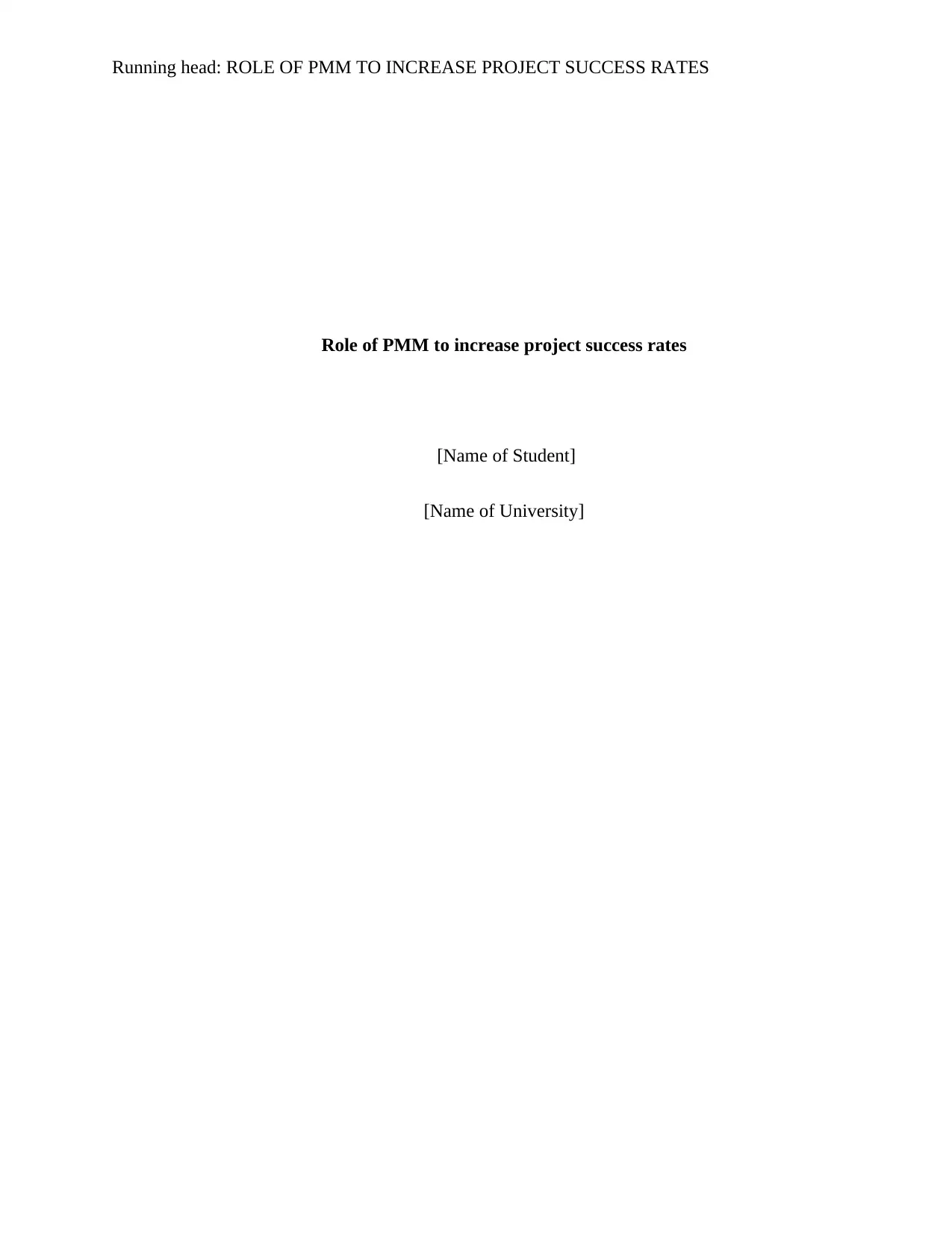
Running head: ROLE OF PMM TO INCREASE PROJECT SUCCESS RATES
Role of PMM to increase project success rates
[Name of Student]
[Name of University]
Role of PMM to increase project success rates
[Name of Student]
[Name of University]
Paraphrase This Document
Need a fresh take? Get an instant paraphrase of this document with our AI Paraphraser

ROLE OF PMM TO INCREASE PROJECT SUCCESS RATES
ACKNOWLEDGEMENT
ACKNOWLEDGEMENT

ROLE OF PMM TO INCREASE PROJECT SUCCESS RATES
Executive Summary
Executive Summary
⊘ This is a preview!⊘
Do you want full access?
Subscribe today to unlock all pages.

Trusted by 1+ million students worldwide
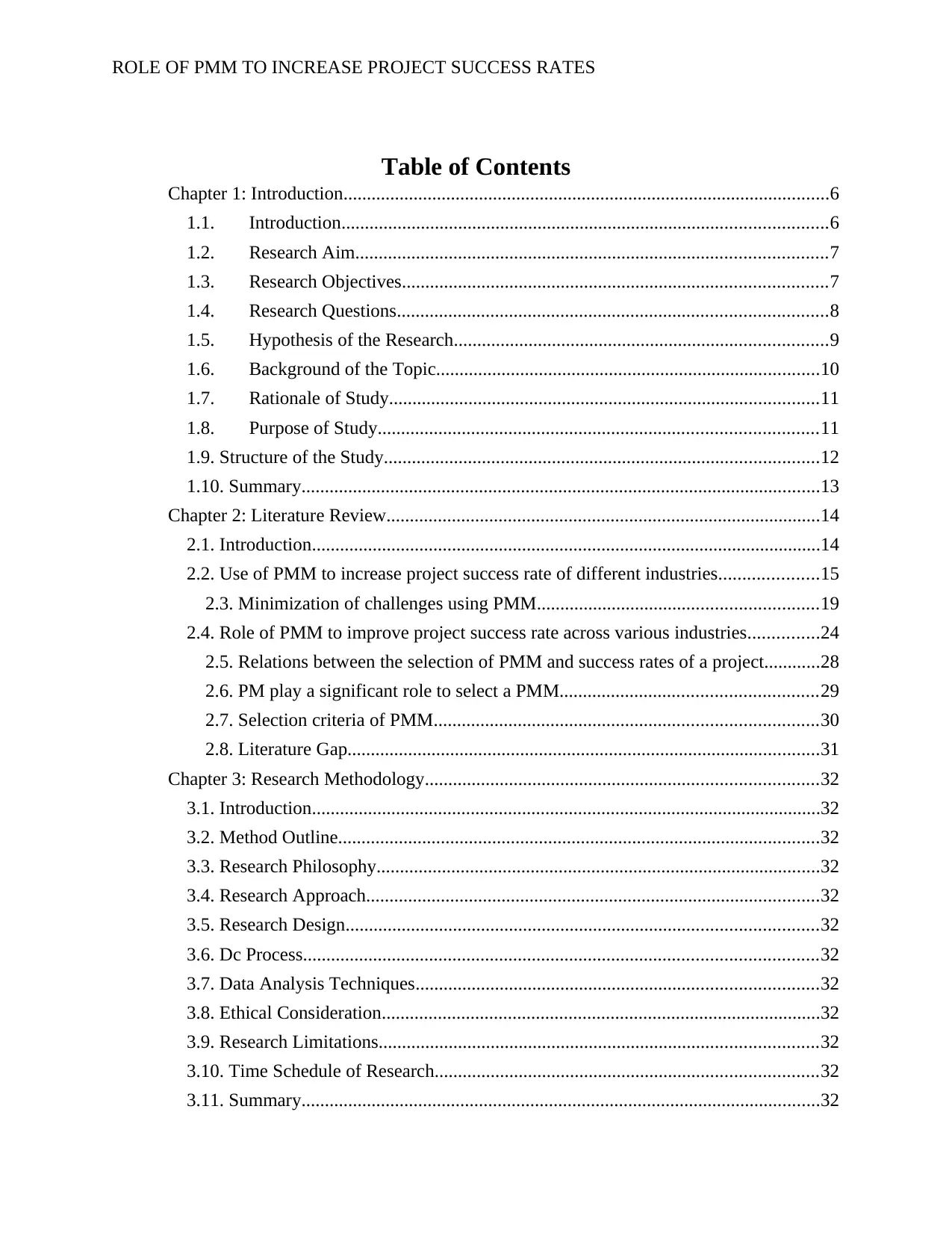
ROLE OF PMM TO INCREASE PROJECT SUCCESS RATES
Table of Contents
Chapter 1: Introduction........................................................................................................6
1.1. Introduction........................................................................................................6
1.2. Research Aim.....................................................................................................7
1.3. Research Objectives...........................................................................................7
1.4. Research Questions............................................................................................8
1.5. Hypothesis of the Research................................................................................9
1.6. Background of the Topic..................................................................................10
1.7. Rationale of Study............................................................................................11
1.8. Purpose of Study..............................................................................................11
1.9. Structure of the Study.............................................................................................12
1.10. Summary...............................................................................................................13
Chapter 2: Literature Review.............................................................................................14
2.1. Introduction.............................................................................................................14
2.2. Use of PMM to increase project success rate of different industries.....................15
2.3. Minimization of challenges using PMM............................................................19
2.4. Role of PMM to improve project success rate across various industries...............24
2.5. Relations between the selection of PMM and success rates of a project............28
2.6. PM play a significant role to select a PMM.......................................................29
2.7. Selection criteria of PMM..................................................................................30
2.8. Literature Gap.....................................................................................................31
Chapter 3: Research Methodology....................................................................................32
3.1. Introduction.............................................................................................................32
3.2. Method Outline.......................................................................................................32
3.3. Research Philosophy...............................................................................................32
3.4. Research Approach.................................................................................................32
3.5. Research Design.....................................................................................................32
3.6. Dc Process..............................................................................................................32
3.7. Data Analysis Techniques......................................................................................32
3.8. Ethical Consideration..............................................................................................32
3.9. Research Limitations..............................................................................................32
3.10. Time Schedule of Research..................................................................................32
3.11. Summary...............................................................................................................32
Table of Contents
Chapter 1: Introduction........................................................................................................6
1.1. Introduction........................................................................................................6
1.2. Research Aim.....................................................................................................7
1.3. Research Objectives...........................................................................................7
1.4. Research Questions............................................................................................8
1.5. Hypothesis of the Research................................................................................9
1.6. Background of the Topic..................................................................................10
1.7. Rationale of Study............................................................................................11
1.8. Purpose of Study..............................................................................................11
1.9. Structure of the Study.............................................................................................12
1.10. Summary...............................................................................................................13
Chapter 2: Literature Review.............................................................................................14
2.1. Introduction.............................................................................................................14
2.2. Use of PMM to increase project success rate of different industries.....................15
2.3. Minimization of challenges using PMM............................................................19
2.4. Role of PMM to improve project success rate across various industries...............24
2.5. Relations between the selection of PMM and success rates of a project............28
2.6. PM play a significant role to select a PMM.......................................................29
2.7. Selection criteria of PMM..................................................................................30
2.8. Literature Gap.....................................................................................................31
Chapter 3: Research Methodology....................................................................................32
3.1. Introduction.............................................................................................................32
3.2. Method Outline.......................................................................................................32
3.3. Research Philosophy...............................................................................................32
3.4. Research Approach.................................................................................................32
3.5. Research Design.....................................................................................................32
3.6. Dc Process..............................................................................................................32
3.7. Data Analysis Techniques......................................................................................32
3.8. Ethical Consideration..............................................................................................32
3.9. Research Limitations..............................................................................................32
3.10. Time Schedule of Research..................................................................................32
3.11. Summary...............................................................................................................32
Paraphrase This Document
Need a fresh take? Get an instant paraphrase of this document with our AI Paraphraser

ROLE OF PMM TO INCREASE PROJECT SUCCESS RATES
Chapter 4: Data Analysis, Findings and Interpretation.....................................................33
4.1. Introduction.............................................................................................................33
4.2. Quantitative Analysis..............................................................................................33
4.3. Summary.................................................................................................................33
Chapter 5: Conclusion and Recommendations..................................................................34
5.1. Conclusions.............................................................................................................34
5.2. Linking with Objectives.........................................................................................34
5.3. Recommendations...................................................................................................34
5.4. Limitations of Study...............................................................................................34
5.5. Further Scope of Study...........................................................................................34
References..........................................................................................................................35
Chapter 4: Data Analysis, Findings and Interpretation.....................................................33
4.1. Introduction.............................................................................................................33
4.2. Quantitative Analysis..............................................................................................33
4.3. Summary.................................................................................................................33
Chapter 5: Conclusion and Recommendations..................................................................34
5.1. Conclusions.............................................................................................................34
5.2. Linking with Objectives.........................................................................................34
5.3. Recommendations...................................................................................................34
5.4. Limitations of Study...............................................................................................34
5.5. Further Scope of Study...........................................................................................34
References..........................................................................................................................35
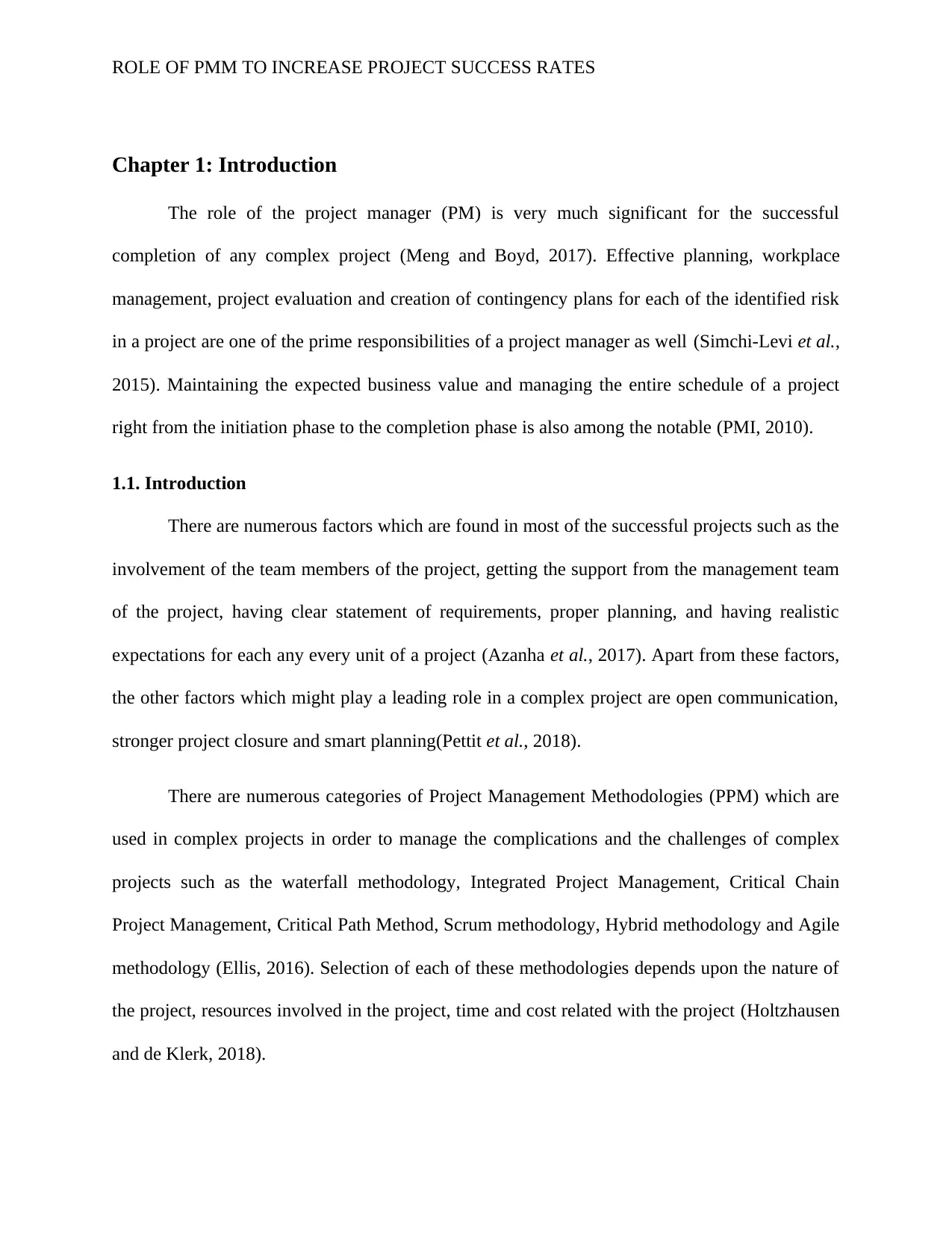
ROLE OF PMM TO INCREASE PROJECT SUCCESS RATES
Chapter 1: Introduction
The role of the project manager (PM) is very much significant for the successful
completion of any complex project (Meng and Boyd, 2017). Effective planning, workplace
management, project evaluation and creation of contingency plans for each of the identified risk
in a project are one of the prime responsibilities of a project manager as well (Simchi-Levi et al.,
2015). Maintaining the expected business value and managing the entire schedule of a project
right from the initiation phase to the completion phase is also among the notable (PMI, 2010).
1.1. Introduction
There are numerous factors which are found in most of the successful projects such as the
involvement of the team members of the project, getting the support from the management team
of the project, having clear statement of requirements, proper planning, and having realistic
expectations for each any every unit of a project (Azanha et al., 2017). Apart from these factors,
the other factors which might play a leading role in a complex project are open communication,
stronger project closure and smart planning(Pettit et al., 2018).
There are numerous categories of Project Management Methodologies (PPM) which are
used in complex projects in order to manage the complications and the challenges of complex
projects such as the waterfall methodology, Integrated Project Management, Critical Chain
Project Management, Critical Path Method, Scrum methodology, Hybrid methodology and Agile
methodology (Ellis, 2016). Selection of each of these methodologies depends upon the nature of
the project, resources involved in the project, time and cost related with the project (Holtzhausen
and de Klerk, 2018).
Chapter 1: Introduction
The role of the project manager (PM) is very much significant for the successful
completion of any complex project (Meng and Boyd, 2017). Effective planning, workplace
management, project evaluation and creation of contingency plans for each of the identified risk
in a project are one of the prime responsibilities of a project manager as well (Simchi-Levi et al.,
2015). Maintaining the expected business value and managing the entire schedule of a project
right from the initiation phase to the completion phase is also among the notable (PMI, 2010).
1.1. Introduction
There are numerous factors which are found in most of the successful projects such as the
involvement of the team members of the project, getting the support from the management team
of the project, having clear statement of requirements, proper planning, and having realistic
expectations for each any every unit of a project (Azanha et al., 2017). Apart from these factors,
the other factors which might play a leading role in a complex project are open communication,
stronger project closure and smart planning(Pettit et al., 2018).
There are numerous categories of Project Management Methodologies (PPM) which are
used in complex projects in order to manage the complications and the challenges of complex
projects such as the waterfall methodology, Integrated Project Management, Critical Chain
Project Management, Critical Path Method, Scrum methodology, Hybrid methodology and Agile
methodology (Ellis, 2016). Selection of each of these methodologies depends upon the nature of
the project, resources involved in the project, time and cost related with the project (Holtzhausen
and de Klerk, 2018).
⊘ This is a preview!⊘
Do you want full access?
Subscribe today to unlock all pages.

Trusted by 1+ million students worldwide
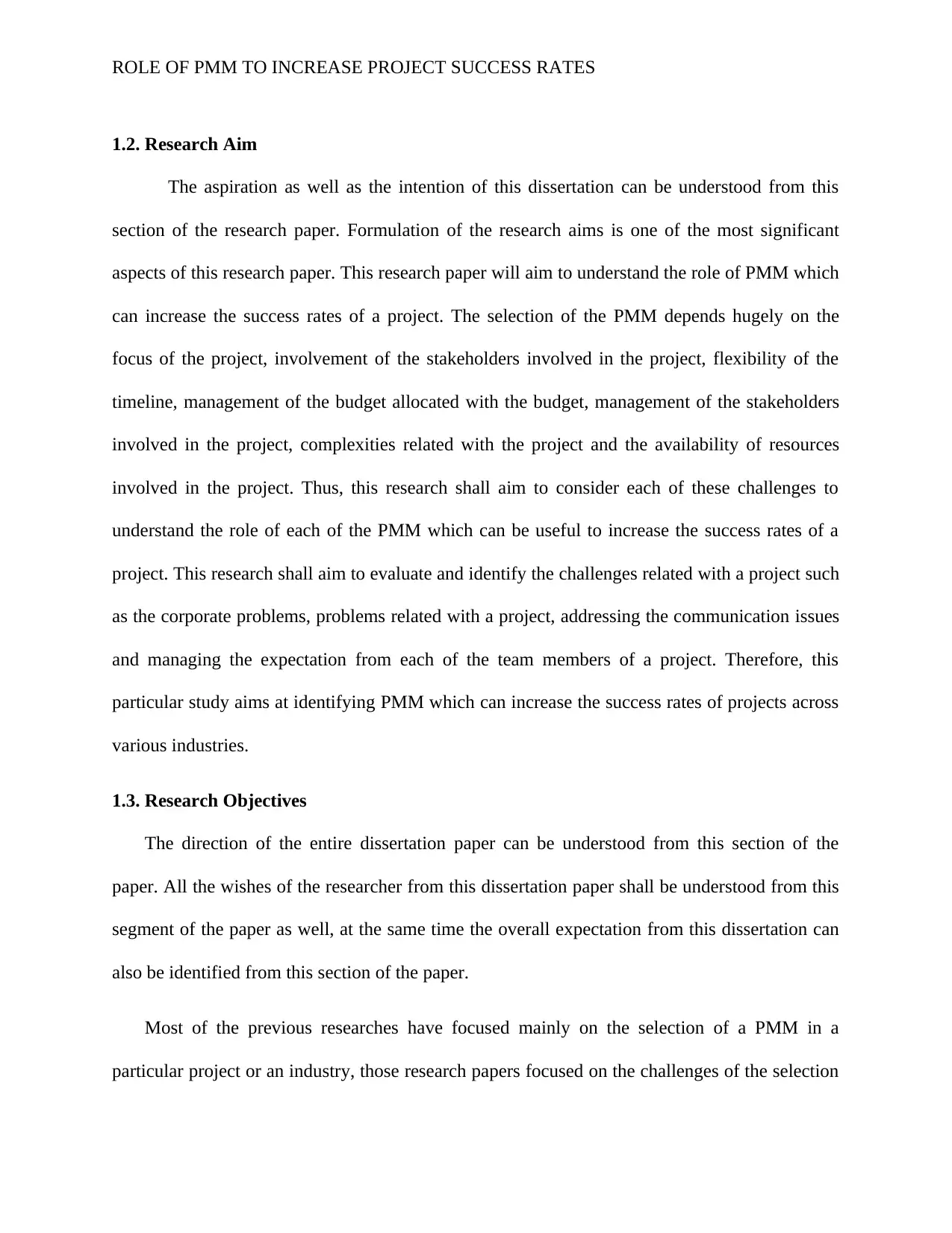
ROLE OF PMM TO INCREASE PROJECT SUCCESS RATES
1.2. Research Aim
The aspiration as well as the intention of this dissertation can be understood from this
section of the research paper. Formulation of the research aims is one of the most significant
aspects of this research paper. This research paper will aim to understand the role of PMM which
can increase the success rates of a project. The selection of the PMM depends hugely on the
focus of the project, involvement of the stakeholders involved in the project, flexibility of the
timeline, management of the budget allocated with the budget, management of the stakeholders
involved in the project, complexities related with the project and the availability of resources
involved in the project. Thus, this research shall aim to consider each of these challenges to
understand the role of each of the PMM which can be useful to increase the success rates of a
project. This research shall aim to evaluate and identify the challenges related with a project such
as the corporate problems, problems related with a project, addressing the communication issues
and managing the expectation from each of the team members of a project. Therefore, this
particular study aims at identifying PMM which can increase the success rates of projects across
various industries.
1.3. Research Objectives
The direction of the entire dissertation paper can be understood from this section of the
paper. All the wishes of the researcher from this dissertation paper shall be understood from this
segment of the paper as well, at the same time the overall expectation from this dissertation can
also be identified from this section of the paper.
Most of the previous researches have focused mainly on the selection of a PMM in a
particular project or an industry, those research papers focused on the challenges of the selection
1.2. Research Aim
The aspiration as well as the intention of this dissertation can be understood from this
section of the research paper. Formulation of the research aims is one of the most significant
aspects of this research paper. This research paper will aim to understand the role of PMM which
can increase the success rates of a project. The selection of the PMM depends hugely on the
focus of the project, involvement of the stakeholders involved in the project, flexibility of the
timeline, management of the budget allocated with the budget, management of the stakeholders
involved in the project, complexities related with the project and the availability of resources
involved in the project. Thus, this research shall aim to consider each of these challenges to
understand the role of each of the PMM which can be useful to increase the success rates of a
project. This research shall aim to evaluate and identify the challenges related with a project such
as the corporate problems, problems related with a project, addressing the communication issues
and managing the expectation from each of the team members of a project. Therefore, this
particular study aims at identifying PMM which can increase the success rates of projects across
various industries.
1.3. Research Objectives
The direction of the entire dissertation paper can be understood from this section of the
paper. All the wishes of the researcher from this dissertation paper shall be understood from this
segment of the paper as well, at the same time the overall expectation from this dissertation can
also be identified from this section of the paper.
Most of the previous researches have focused mainly on the selection of a PMM in a
particular project or an industry, those research papers focused on the challenges of the selection
Paraphrase This Document
Need a fresh take? Get an instant paraphrase of this document with our AI Paraphraser
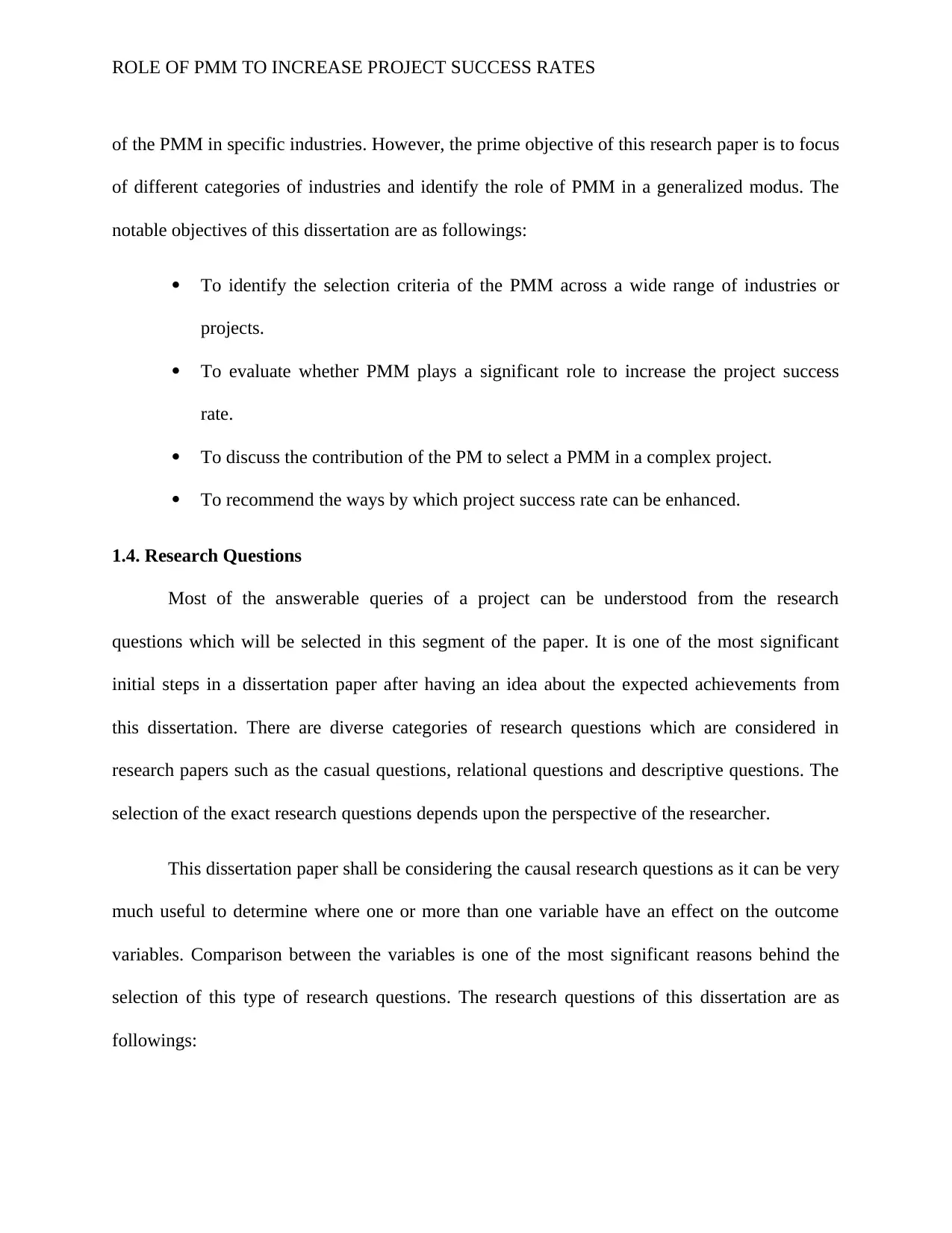
ROLE OF PMM TO INCREASE PROJECT SUCCESS RATES
of the PMM in specific industries. However, the prime objective of this research paper is to focus
of different categories of industries and identify the role of PMM in a generalized modus. The
notable objectives of this dissertation are as followings:
To identify the selection criteria of the PMM across a wide range of industries or
projects.
To evaluate whether PMM plays a significant role to increase the project success
rate.
To discuss the contribution of the PM to select a PMM in a complex project.
To recommend the ways by which project success rate can be enhanced.
1.4. Research Questions
Most of the answerable queries of a project can be understood from the research
questions which will be selected in this segment of the paper. It is one of the most significant
initial steps in a dissertation paper after having an idea about the expected achievements from
this dissertation. There are diverse categories of research questions which are considered in
research papers such as the casual questions, relational questions and descriptive questions. The
selection of the exact research questions depends upon the perspective of the researcher.
This dissertation paper shall be considering the causal research questions as it can be very
much useful to determine where one or more than one variable have an effect on the outcome
variables. Comparison between the variables is one of the most significant reasons behind the
selection of this type of research questions. The research questions of this dissertation are as
followings:
of the PMM in specific industries. However, the prime objective of this research paper is to focus
of different categories of industries and identify the role of PMM in a generalized modus. The
notable objectives of this dissertation are as followings:
To identify the selection criteria of the PMM across a wide range of industries or
projects.
To evaluate whether PMM plays a significant role to increase the project success
rate.
To discuss the contribution of the PM to select a PMM in a complex project.
To recommend the ways by which project success rate can be enhanced.
1.4. Research Questions
Most of the answerable queries of a project can be understood from the research
questions which will be selected in this segment of the paper. It is one of the most significant
initial steps in a dissertation paper after having an idea about the expected achievements from
this dissertation. There are diverse categories of research questions which are considered in
research papers such as the casual questions, relational questions and descriptive questions. The
selection of the exact research questions depends upon the perspective of the researcher.
This dissertation paper shall be considering the causal research questions as it can be very
much useful to determine where one or more than one variable have an effect on the outcome
variables. Comparison between the variables is one of the most significant reasons behind the
selection of this type of research questions. The research questions of this dissertation are as
followings:
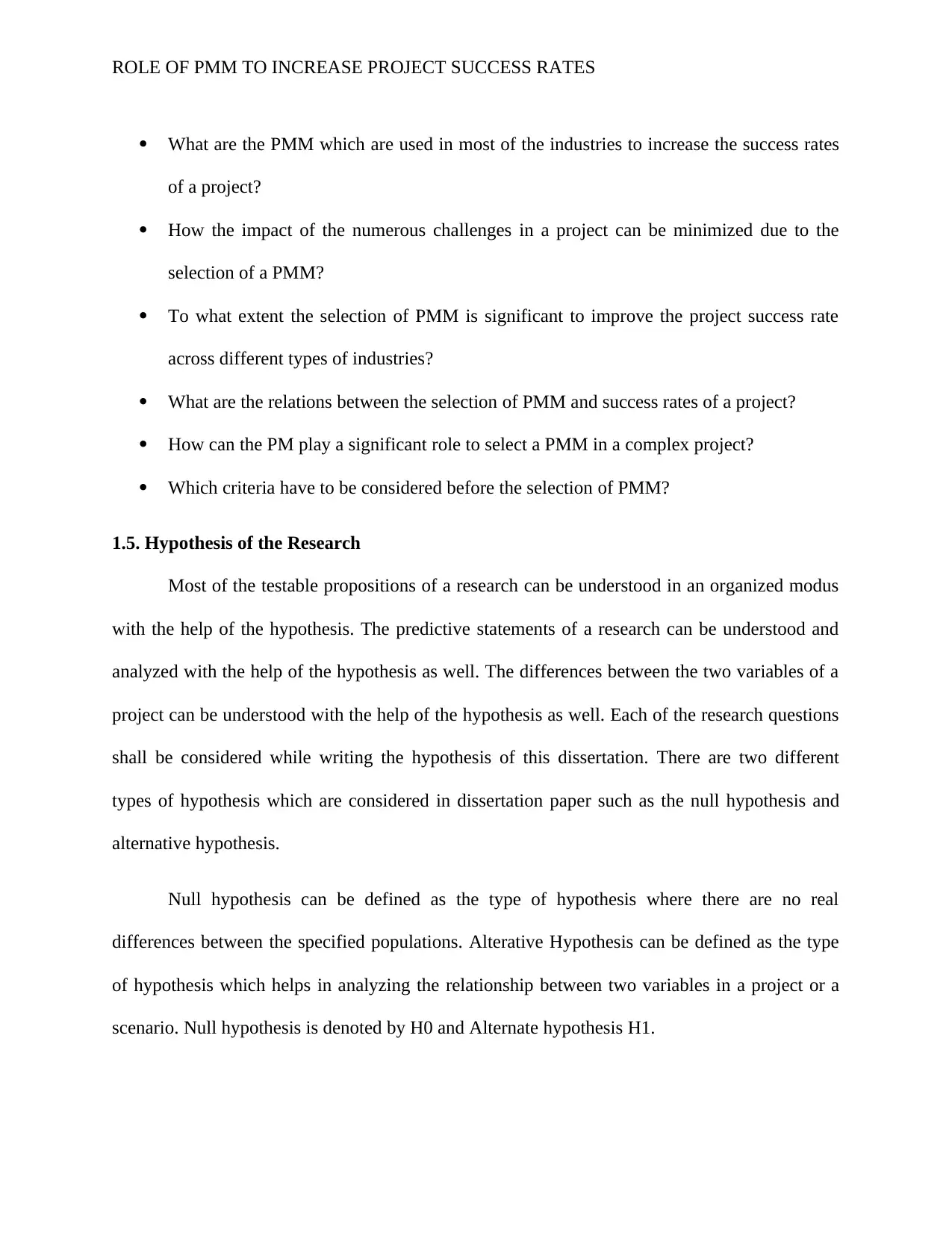
ROLE OF PMM TO INCREASE PROJECT SUCCESS RATES
What are the PMM which are used in most of the industries to increase the success rates
of a project?
How the impact of the numerous challenges in a project can be minimized due to the
selection of a PMM?
To what extent the selection of PMM is significant to improve the project success rate
across different types of industries?
What are the relations between the selection of PMM and success rates of a project?
How can the PM play a significant role to select a PMM in a complex project?
Which criteria have to be considered before the selection of PMM?
1.5. Hypothesis of the Research
Most of the testable propositions of a research can be understood in an organized modus
with the help of the hypothesis. The predictive statements of a research can be understood and
analyzed with the help of the hypothesis as well. The differences between the two variables of a
project can be understood with the help of the hypothesis as well. Each of the research questions
shall be considered while writing the hypothesis of this dissertation. There are two different
types of hypothesis which are considered in dissertation paper such as the null hypothesis and
alternative hypothesis.
Null hypothesis can be defined as the type of hypothesis where there are no real
differences between the specified populations. Alterative Hypothesis can be defined as the type
of hypothesis which helps in analyzing the relationship between two variables in a project or a
scenario. Null hypothesis is denoted by H0 and Alternate hypothesis H1.
What are the PMM which are used in most of the industries to increase the success rates
of a project?
How the impact of the numerous challenges in a project can be minimized due to the
selection of a PMM?
To what extent the selection of PMM is significant to improve the project success rate
across different types of industries?
What are the relations between the selection of PMM and success rates of a project?
How can the PM play a significant role to select a PMM in a complex project?
Which criteria have to be considered before the selection of PMM?
1.5. Hypothesis of the Research
Most of the testable propositions of a research can be understood in an organized modus
with the help of the hypothesis. The predictive statements of a research can be understood and
analyzed with the help of the hypothesis as well. The differences between the two variables of a
project can be understood with the help of the hypothesis as well. Each of the research questions
shall be considered while writing the hypothesis of this dissertation. There are two different
types of hypothesis which are considered in dissertation paper such as the null hypothesis and
alternative hypothesis.
Null hypothesis can be defined as the type of hypothesis where there are no real
differences between the specified populations. Alterative Hypothesis can be defined as the type
of hypothesis which helps in analyzing the relationship between two variables in a project or a
scenario. Null hypothesis is denoted by H0 and Alternate hypothesis H1.
⊘ This is a preview!⊘
Do you want full access?
Subscribe today to unlock all pages.

Trusted by 1+ million students worldwide
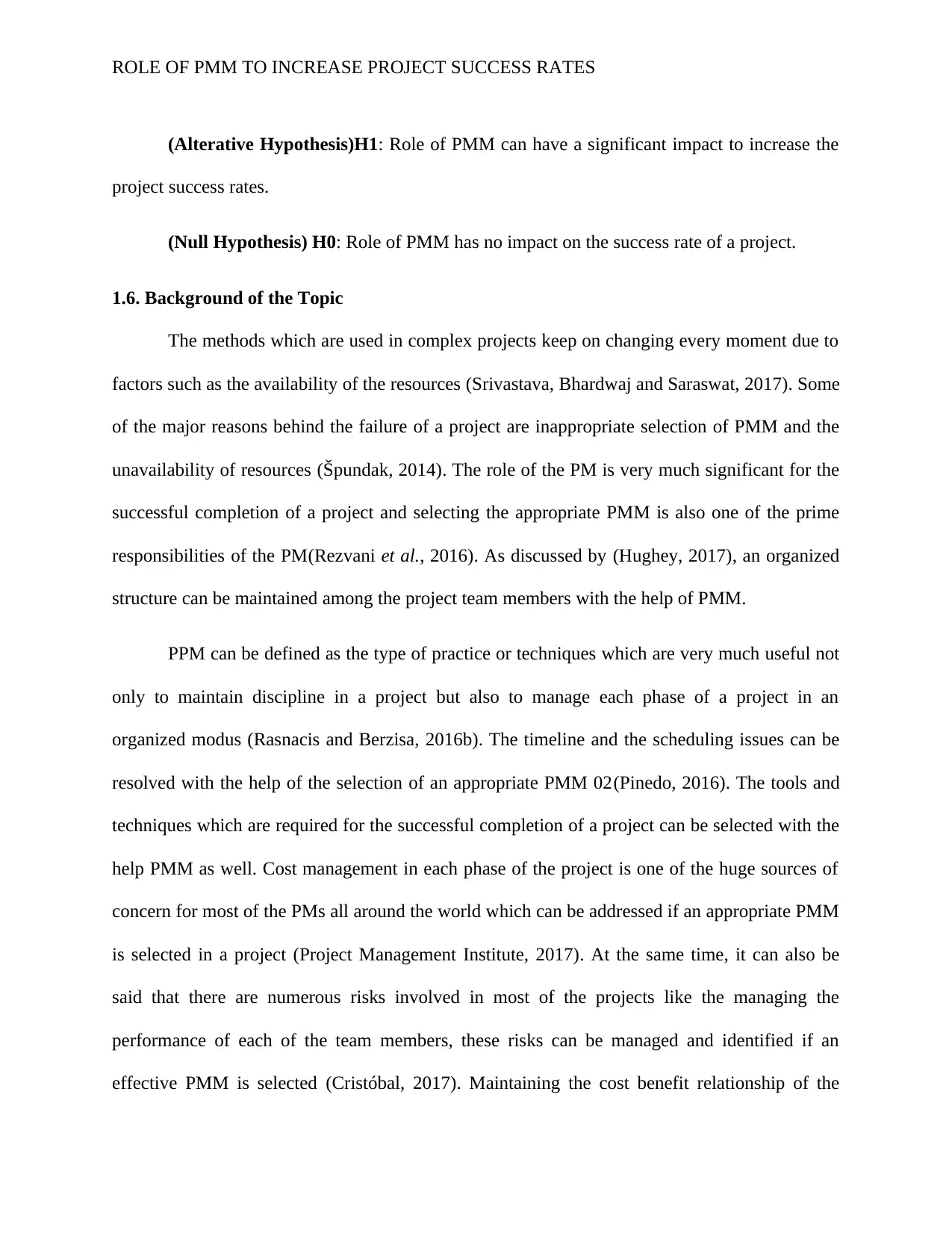
ROLE OF PMM TO INCREASE PROJECT SUCCESS RATES
(Alterative Hypothesis)H1: Role of PMM can have a significant impact to increase the
project success rates.
(Null Hypothesis) H0: Role of PMM has no impact on the success rate of a project.
1.6. Background of the Topic
The methods which are used in complex projects keep on changing every moment due to
factors such as the availability of the resources (Srivastava, Bhardwaj and Saraswat, 2017). Some
of the major reasons behind the failure of a project are inappropriate selection of PMM and the
unavailability of resources (Špundak, 2014). The role of the PM is very much significant for the
successful completion of a project and selecting the appropriate PMM is also one of the prime
responsibilities of the PM(Rezvani et al., 2016). As discussed by (Hughey, 2017), an organized
structure can be maintained among the project team members with the help of PMM.
PPM can be defined as the type of practice or techniques which are very much useful not
only to maintain discipline in a project but also to manage each phase of a project in an
organized modus (Rasnacis and Berzisa, 2016b). The timeline and the scheduling issues can be
resolved with the help of the selection of an appropriate PMM 02(Pinedo, 2016). The tools and
techniques which are required for the successful completion of a project can be selected with the
help PMM as well. Cost management in each phase of the project is one of the huge sources of
concern for most of the PMs all around the world which can be addressed if an appropriate PMM
is selected in a project (Project Management Institute, 2017). At the same time, it can also be
said that there are numerous risks involved in most of the projects like the managing the
performance of each of the team members, these risks can be managed and identified if an
effective PMM is selected (Cristóbal, 2017). Maintaining the cost benefit relationship of the
(Alterative Hypothesis)H1: Role of PMM can have a significant impact to increase the
project success rates.
(Null Hypothesis) H0: Role of PMM has no impact on the success rate of a project.
1.6. Background of the Topic
The methods which are used in complex projects keep on changing every moment due to
factors such as the availability of the resources (Srivastava, Bhardwaj and Saraswat, 2017). Some
of the major reasons behind the failure of a project are inappropriate selection of PMM and the
unavailability of resources (Špundak, 2014). The role of the PM is very much significant for the
successful completion of a project and selecting the appropriate PMM is also one of the prime
responsibilities of the PM(Rezvani et al., 2016). As discussed by (Hughey, 2017), an organized
structure can be maintained among the project team members with the help of PMM.
PPM can be defined as the type of practice or techniques which are very much useful not
only to maintain discipline in a project but also to manage each phase of a project in an
organized modus (Rasnacis and Berzisa, 2016b). The timeline and the scheduling issues can be
resolved with the help of the selection of an appropriate PMM 02(Pinedo, 2016). The tools and
techniques which are required for the successful completion of a project can be selected with the
help PMM as well. Cost management in each phase of the project is one of the huge sources of
concern for most of the PMs all around the world which can be addressed if an appropriate PMM
is selected in a project (Project Management Institute, 2017). At the same time, it can also be
said that there are numerous risks involved in most of the projects like the managing the
performance of each of the team members, these risks can be managed and identified if an
effective PMM is selected (Cristóbal, 2017). Maintaining the cost benefit relationship of the
Paraphrase This Document
Need a fresh take? Get an instant paraphrase of this document with our AI Paraphraser
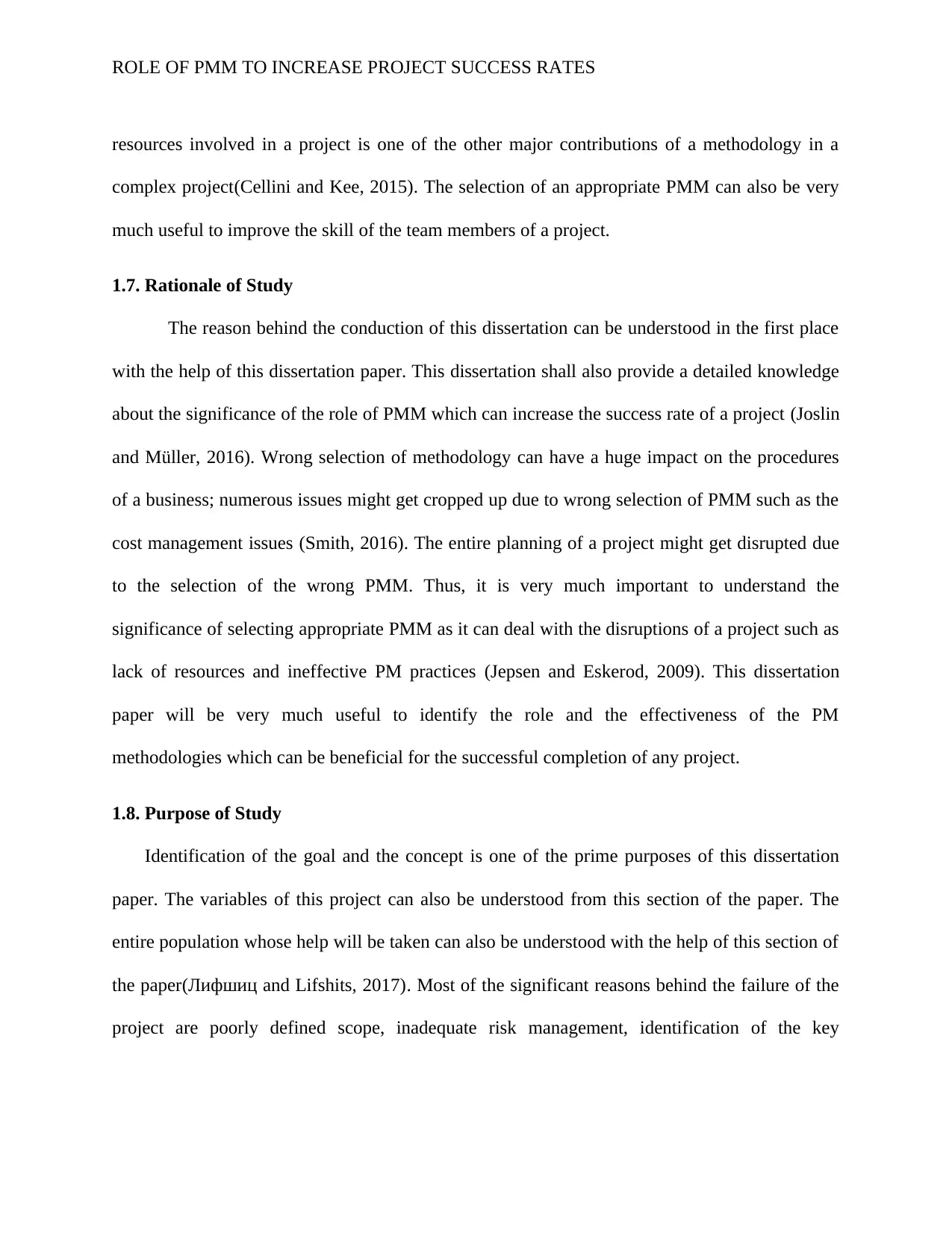
ROLE OF PMM TO INCREASE PROJECT SUCCESS RATES
resources involved in a project is one of the other major contributions of a methodology in a
complex project(Cellini and Kee, 2015). The selection of an appropriate PMM can also be very
much useful to improve the skill of the team members of a project.
1.7. Rationale of Study
The reason behind the conduction of this dissertation can be understood in the first place
with the help of this dissertation paper. This dissertation shall also provide a detailed knowledge
about the significance of the role of PMM which can increase the success rate of a project (Joslin
and Müller, 2016). Wrong selection of methodology can have a huge impact on the procedures
of a business; numerous issues might get cropped up due to wrong selection of PMM such as the
cost management issues (Smith, 2016). The entire planning of a project might get disrupted due
to the selection of the wrong PMM. Thus, it is very much important to understand the
significance of selecting appropriate PMM as it can deal with the disruptions of a project such as
lack of resources and ineffective PM practices (Jepsen and Eskerod, 2009). This dissertation
paper will be very much useful to identify the role and the effectiveness of the PM
methodologies which can be beneficial for the successful completion of any project.
1.8. Purpose of Study
Identification of the goal and the concept is one of the prime purposes of this dissertation
paper. The variables of this project can also be understood from this section of the paper. The
entire population whose help will be taken can also be understood with the help of this section of
the paper(Лифшиц and Lifshits, 2017). Most of the significant reasons behind the failure of the
project are poorly defined scope, inadequate risk management, identification of the key
resources involved in a project is one of the other major contributions of a methodology in a
complex project(Cellini and Kee, 2015). The selection of an appropriate PMM can also be very
much useful to improve the skill of the team members of a project.
1.7. Rationale of Study
The reason behind the conduction of this dissertation can be understood in the first place
with the help of this dissertation paper. This dissertation shall also provide a detailed knowledge
about the significance of the role of PMM which can increase the success rate of a project (Joslin
and Müller, 2016). Wrong selection of methodology can have a huge impact on the procedures
of a business; numerous issues might get cropped up due to wrong selection of PMM such as the
cost management issues (Smith, 2016). The entire planning of a project might get disrupted due
to the selection of the wrong PMM. Thus, it is very much important to understand the
significance of selecting appropriate PMM as it can deal with the disruptions of a project such as
lack of resources and ineffective PM practices (Jepsen and Eskerod, 2009). This dissertation
paper will be very much useful to identify the role and the effectiveness of the PM
methodologies which can be beneficial for the successful completion of any project.
1.8. Purpose of Study
Identification of the goal and the concept is one of the prime purposes of this dissertation
paper. The variables of this project can also be understood from this section of the paper. The
entire population whose help will be taken can also be understood with the help of this section of
the paper(Лифшиц and Lifshits, 2017). Most of the significant reasons behind the failure of the
project are poorly defined scope, inadequate risk management, identification of the key
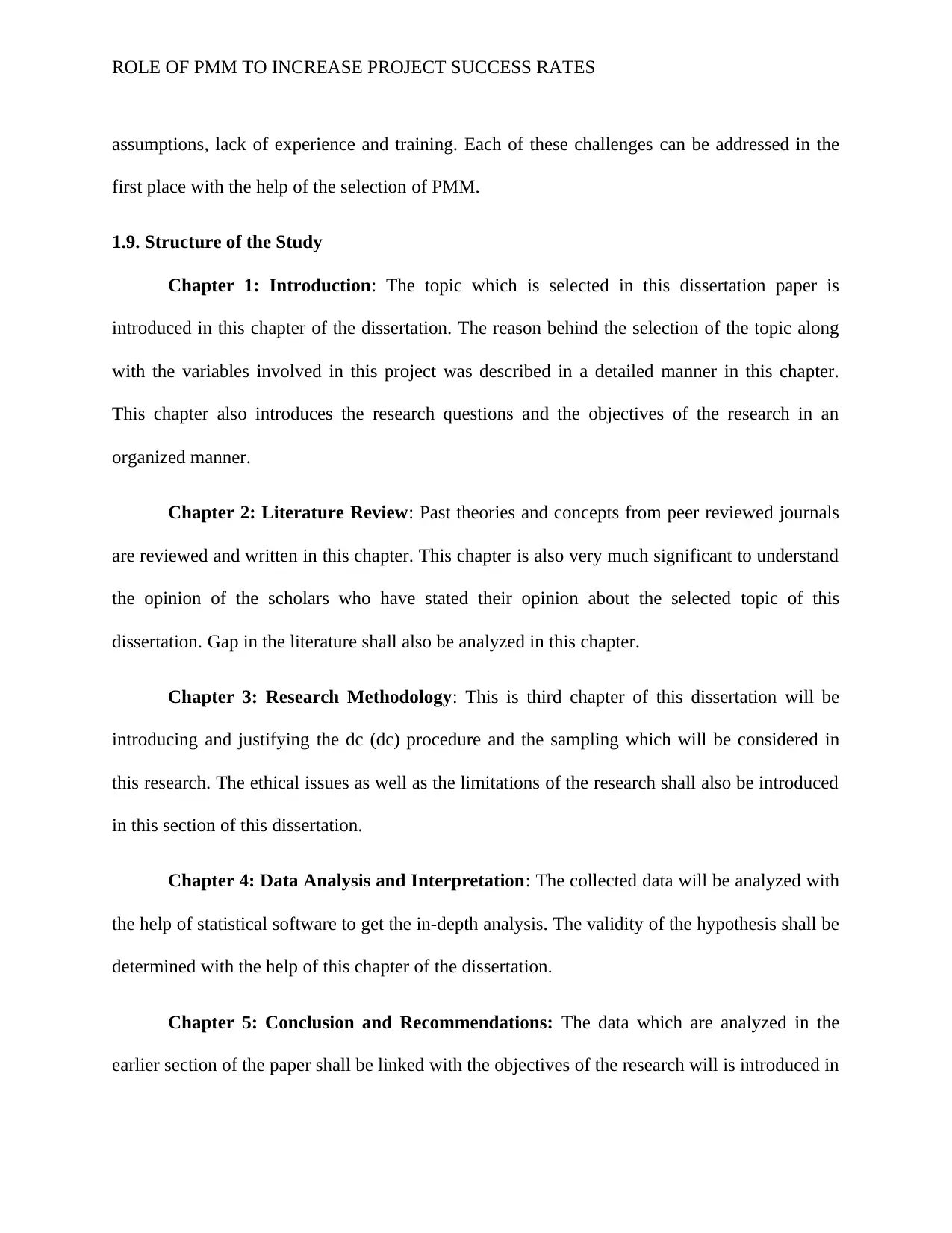
ROLE OF PMM TO INCREASE PROJECT SUCCESS RATES
assumptions, lack of experience and training. Each of these challenges can be addressed in the
first place with the help of the selection of PMM.
1.9. Structure of the Study
Chapter 1: Introduction: The topic which is selected in this dissertation paper is
introduced in this chapter of the dissertation. The reason behind the selection of the topic along
with the variables involved in this project was described in a detailed manner in this chapter.
This chapter also introduces the research questions and the objectives of the research in an
organized manner.
Chapter 2: Literature Review: Past theories and concepts from peer reviewed journals
are reviewed and written in this chapter. This chapter is also very much significant to understand
the opinion of the scholars who have stated their opinion about the selected topic of this
dissertation. Gap in the literature shall also be analyzed in this chapter.
Chapter 3: Research Methodology: This is third chapter of this dissertation will be
introducing and justifying the dc (dc) procedure and the sampling which will be considered in
this research. The ethical issues as well as the limitations of the research shall also be introduced
in this section of this dissertation.
Chapter 4: Data Analysis and Interpretation: The collected data will be analyzed with
the help of statistical software to get the in-depth analysis. The validity of the hypothesis shall be
determined with the help of this chapter of the dissertation.
Chapter 5: Conclusion and Recommendations: The data which are analyzed in the
earlier section of the paper shall be linked with the objectives of the research will is introduced in
assumptions, lack of experience and training. Each of these challenges can be addressed in the
first place with the help of the selection of PMM.
1.9. Structure of the Study
Chapter 1: Introduction: The topic which is selected in this dissertation paper is
introduced in this chapter of the dissertation. The reason behind the selection of the topic along
with the variables involved in this project was described in a detailed manner in this chapter.
This chapter also introduces the research questions and the objectives of the research in an
organized manner.
Chapter 2: Literature Review: Past theories and concepts from peer reviewed journals
are reviewed and written in this chapter. This chapter is also very much significant to understand
the opinion of the scholars who have stated their opinion about the selected topic of this
dissertation. Gap in the literature shall also be analyzed in this chapter.
Chapter 3: Research Methodology: This is third chapter of this dissertation will be
introducing and justifying the dc (dc) procedure and the sampling which will be considered in
this research. The ethical issues as well as the limitations of the research shall also be introduced
in this section of this dissertation.
Chapter 4: Data Analysis and Interpretation: The collected data will be analyzed with
the help of statistical software to get the in-depth analysis. The validity of the hypothesis shall be
determined with the help of this chapter of the dissertation.
Chapter 5: Conclusion and Recommendations: The data which are analyzed in the
earlier section of the paper shall be linked with the objectives of the research will is introduced in
⊘ This is a preview!⊘
Do you want full access?
Subscribe today to unlock all pages.

Trusted by 1+ million students worldwide
1 out of 61
Related Documents
Your All-in-One AI-Powered Toolkit for Academic Success.
+13062052269
info@desklib.com
Available 24*7 on WhatsApp / Email
![[object Object]](/_next/static/media/star-bottom.7253800d.svg)
Unlock your academic potential
Copyright © 2020–2025 A2Z Services. All Rights Reserved. Developed and managed by ZUCOL.





